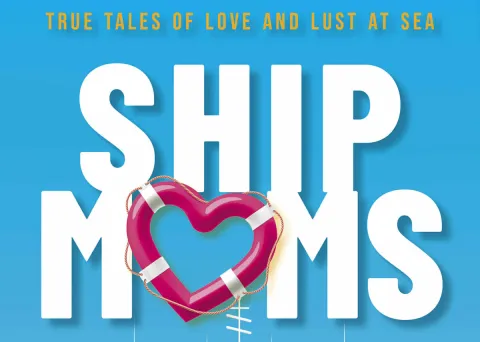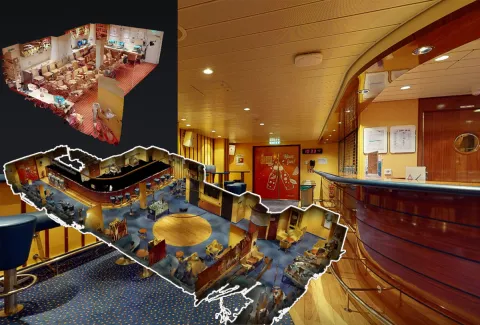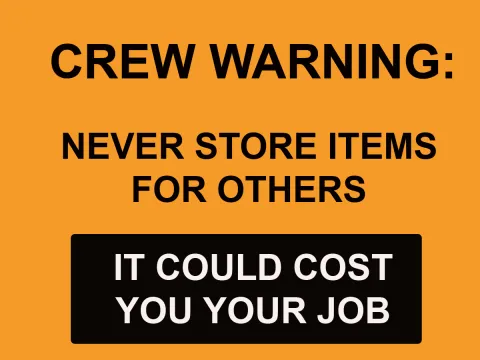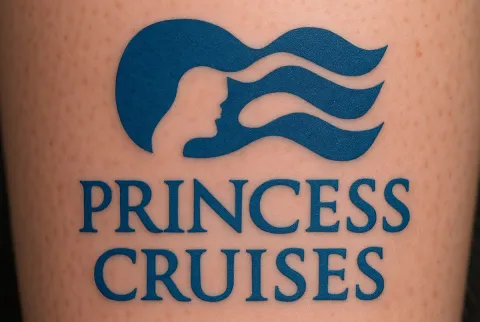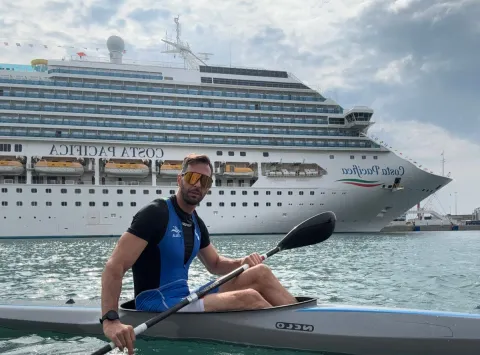
by Nancy Soulé
So, it’s been a long time since the movie Jaws, but “just when you thought it was safe to go back in the water…” we all wonder if we are really safe from the Covid shark that lurks in the deep. As the cruise ship industry begins to return to service, extensive health protocols have been put in place to protect everyone as best they can. It’s a good thing we’ve got “a bigger boat!” But, for the foreseeable future, for safety’s sake, anyone working in excess of 30 days must endure the mandatory period of 14 days in quarantine onboard. For some, this could be perceived as either prison or vacation! It’s all in your perspective. Confined to a single room, the physical and metal hurdles may be difficult to manage without some preparation. Having endured three of these shipboard quarantines, I offer the following as suggestions for two weeks of survival.
Some companies may require completion of vaccination, others may provide it onboard. Also, 72 hours before departure, you will need to complete a PCR test with paperwork to prove a negative result. This can often be done at a local urgent care or one of your local medical facilities. Transportation to the port will probably be arranged by your company, and sign-on procedures will vary depending on the state of service of the ship. Some, just reviving from an 18-month hibernation, will be in the early processes. The only crew onboard ahead of you may be those handling basic operational deck service, medical staff, and some culinary teams to feed them all. Once systems of housing, health maintenance, and food are established, then you may be allowed onboard in a small group. Health staff will be on hand at boarding to scrutinize medicals, perform temperature checks, and validate the negative results of your PCR test. If you have been vaccinated, be sure that card is completed and ready; they will make a copy of it for their records. I would recommend having it laminated to protect it.
Once admitted onboard, staterooms are in a segregated guest area of the ship marked with “Red Zone” signage to indicate that admittance is only by authorized personnel. So, is this prison or a vacation? Well, by all appearances, this may look like the latter. You have been assigned a comfortable and spacious guest stateroom with a large king-sized bed, a sofa, a desk, a large closet, a big dresser, and… a balcony! Wow! There is also a bar cooler! Depending on how long this ship has been left idol, it may or may not be in cooling condition. But if it is, and you planned ahead, this little appliance could be a lifesaver. If yours is malfunctioning, call maintenance and they may loan you a portable “special needs” cooler.

Here are a few suggestions for the two-weeks. Be aware that there seems to always seems to be a couple of extra days before release.
Food. My first quarantine in October of 2020 required two weeks of lockdown in a hotel in Miami, followed by a 17-hour flight to Singapore, then yet another two weeks quarantine onboard. I received an email asking for my menu selections for each day of the first week. But honestly, the descriptions were very brief, and included some ethnic dishes with names about which I didn’t have a clue. Like trying to read a foreign language for which you’ve only studied lesson one, I tried to identify the words I knew, and had to guess at the rest. There were allowances for vegan and vegetarian options included.
Onboard, breakfast generally was delivered around 7:30 am, lunch from 12:30 to 1pm, and dinner between 6:15 and 7pm. You may have the option to order more than one meal if you’re really hungry, and my digital menu asked if I would like extra rice or bread, and my beverage choices were coffee, tea, milk, and/or juice. I did receive at least one case of bottled water, sometimes two. Each meal was announced by a firm rap on the door as the delivery person scampered away. Your cabin might be equipped with a hot water kettle. If you have a favorite instant coffee or tea, add it to your supply list. Ah the joys of a guest cabin!
When my first experience onboard was over, I found I had put on an extra 15 pounds as the diet seemed loaded with bread, potatoes, rice, as well as lots of sugar in desserts, sauces, and salad dressings. I was on each ship for a bit over 2 months. At the conclusion of the first contract, I was horrified at the readings on the scale and was determined to reverse the situation. When I got home, I spent the next three months consumed with dieting. For the next ship, I vowed that I would skip the bread, potatoes, rice, and sugar as much as possible; that seemed to work pretty well. However, I have to admit that the occasional servings of French fries and chocolate mousse somehow slipped through the cracks in my resolve. Oops. And I went a little crazy with the choices post-quarantine, but I didn’t gain anything back and tried to stick to salads fairly often.
So, in preparation for #2, I packed my suitcase with food to bridge the time gaps and provide some lower calorie snacks. It took some careful weighing to stay under plane regulations, but the bags were lighter coming home. My personal choices:
a) Raw almonds. The big Costco bag can be repackaged into small snack-size bags.
b) SkinnyPop popcorn. I’ve found that a large bag can be divided into about 7 quart-size zip-lock bags that will keep it fresh and meter out the consumption. Takes space, but worth it.
c) Almond butter. Choose a natural smooth-blend brand with minimal oil that won’t separate such as Barney Butter, which does not require refrigeration, and won’t leak in your luggage.
d) Celery. One of my go-to snacks is celery with almond butter. Buy it in precut sticks to simplify preparation. Otherwise, cut, clean, and discard the core before bagging. Two weeks was pretty much the limit of freshness.
e) Canned olives. Black or green, whole or sliced, in pull-top cans. Bring a small plastic watertight package to hold the residual once the can is open to refrigerate. There are also snack-size prepared servings available.
f) Chocolate. Who can live without this? I buy dark chocolate bars and metered the squares out carefully to make then last as long as possible. Nice to mix with a few raw almonds.
Avoid high-fat, highly processed, high-salt snacks and remember to drink a lot of water. Call room service if you need help or want extra food delivered; hopefully they will accommodate you.
Utensils. Meals are delivered in either paper compostable or plastic boxes (thereafter recycled) and utensils are plastic. If you’d prefer something a bit more substantial, bring your own. I found that the compostable boxes sometimes bleed if the food is too liquid, so a small plastic cutting board was helpful to put under the box when I wanted to dine from the comfort of my bed while watching tv without worrying about leaking red spaghetti sauce onto my fresh white duvet.
Clothing. Remember, the only people who will see you are the daily temperature check person, maybe an occasional food delivery staff, or possibly your neighbor as you retrieve your meals. Comfort is the primary concern. You can control the temperature of your cabin and I like to keep mine on the cool side. I find that I spend my days in sweat pants and have two or three tees, long or short- sleeved. I take slippers because I find my feet get cold when I sit too long on the computer or watching tv. I occasionally put on shoes to do some exercise, but I’d rather not have to wash socks. Yoga and stretching are easily done in bare feet.
Laundry
Speaking of socks, laundry may be done in your bathroom sink, or taken with you into the shower. If the ship has a liquid soap dispenser or shampoo, those work well. To use your own, liquid laundry pods run the risk of breaking in your luggage, so an alternative is a few powdered pods like Arm & Hammer.
Exercise. Being locked in one room, maintaining a fitness routine is a challenge. The lure of tv programs and phone or computer games may sidetrack your intentions and give only your thumbs a workout. If you have good and extensive Wi-fi, there are online classes, or use your downloads. But here are some tools that will help:
a) Stretch bands. The ones with handles can be looped over a wall hook or wrapped around a bed leg for various moves. Pilates bands are good too. Tension choices are up to you.
b) Water bottles. You will probably get a case to start. After I’ve drunk the fresh water from the bottles, the 1.5L ones can be refilled with tap water and lashed together with stretchy bands to make weights. In the alternative you could bring a collapsible weight bag that can be filled with water that has handles (Amazon) for doing bicep curls.
c) Laptop. I loaded a few exercise routines onto my laptop to give me someone to follow.
d) Twister. This is a fun little disc that facilitates some waist/ab work called a “Figure Trimmer” (Amazon). It is about a foot in diameter and weighs only a pound. With bearings in the middle and acupressure points under your feet, you can twist as long as you like while watching tv and whittle that waistline.
e) Floor discs. These flat little discs (by Bally) have fabric for hard floors on one side and plastic on the other for use on carpets. Placing your toes on them, you can do ab work like mountain climbers, side twists, or with hands, can work abs by pulling them in/out when on your knees. Handy and easily packable.
f) Wall sitting. Good for abs and legs and requires no tools.
g) Dance. Turn on the music video channel on the television, and DANCE for as long as you can!

Electronics:
a)A cell phone is a given- nobody can survive without one for basic communication. Onboard, some crew trainings, quarantine menus, and important communication from human resources are available.
b)A light-weight laptop will provide work space and entertainment. An additional hard drive for larger files and movies can help. In quarantine, depending on the company, you may have Wi-fi available in various durations. Speed may differ, and I’ve found live Zooms are easier to connect to than replays that take a while to load. Pull yourself away from Facebook for a while and take advantage of the chance to do online courses or learn something on Youtube.
c) Cords for charging everything.
d) A 6 to 10-foot phone charging cord.
e) A 6-foot non-grounded extension cord. Most outlets are not near the bed. Security frowns on extension cords and power strips, but a wimpy one like this is usually ok.
f) A multi-USB hub will facilitate connecting phone, computer, earbuds, etc. at the same time.
Other items:
a) Analogue clock. As the plugs are limited, a battery-operated clock allows for easy adjustment as ship location demands periodic time changes. Nice to have something visible to help you anticipate the joys of meal delivery.
b) Sleep mask. Curtains are usually “black-out” material, but don’t always close completely. Wherever your particular destination, with no specific need to get up early, the sun may have other ideas. An eye mask will help you block it out until you’re ready to get up. That 7am breakfast knock might get you going though.
c) Chip clip. In the same vein, a chip clip or clothes pin will help you secure the curtains.
Quarantine can be a chance to chill out and reconnect with yourself without the demands of work schedules or family obligations. Relish the time. It will be over before you know it. So, consider this as an opportunity and not a requirement. Once returned to “general population” you may find yourself back in either a single or a shared crew cabin… no balcony, no window! Enjoy it while you can
Just remember that once you are “out” it is vital to maintain compliance with the protocols: masks, ID scans, social distancing as much as possible among both crew and guests. No cabin parties. The shark still lurks, so try to stay out of its way. This situation will end eventually, and we’re literally all in the same boat. Be sensible and take care of each other.
Related Article: ADVENTURES in QUARANTINE
Nancy Soulé has worked on cruise ships since 2011. Starting as a jazz vocalist, she is now a theatrical wardrobe contractor for Royal Caribbean where she has served on 25 of the 28 ships in the fleet and traveled worldwide.
Crew Insights
Articles and experiences shared by crew members working on cruise ship. Find out more about ship life at sea together with tips and advices for first time crew members and cruise oldtimers.





